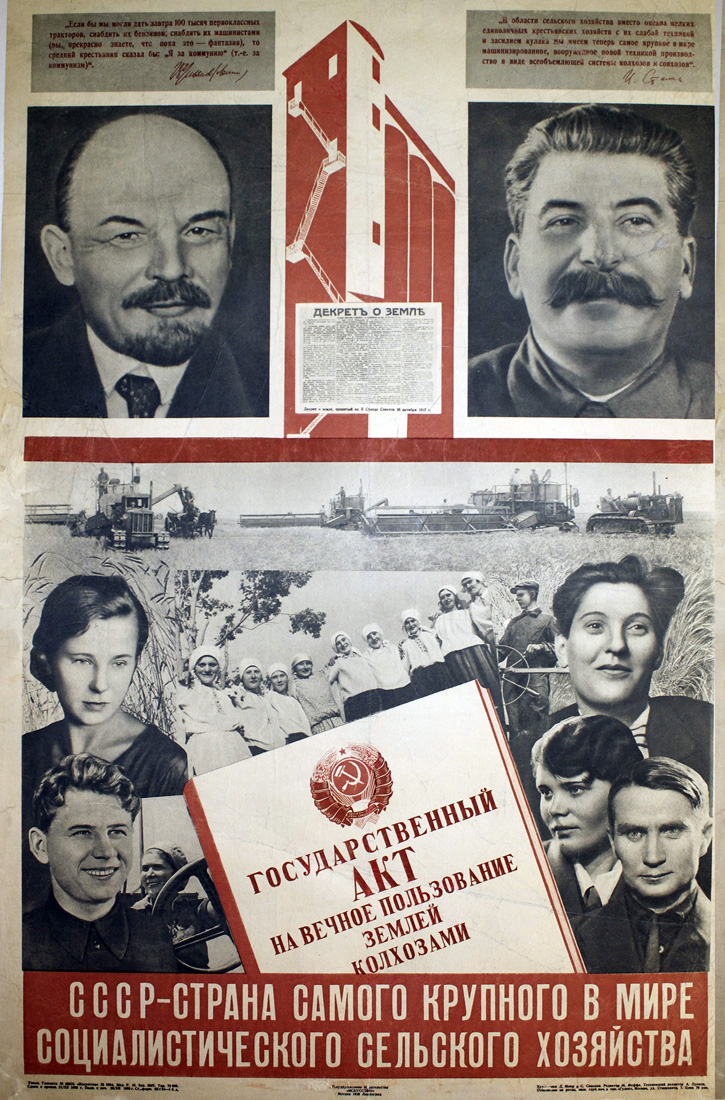
La URSS es el estado con la agricultura socializada más grande del mundo.
Número de Cartel: PP 233
Información sobre el cartel: (En el libro en el centro del cartel) “Ley Nacional para el uso perpetuo de la tierra en las granjas colectivas.” En la parte inferior derechal, con camisa oscura y corbata gris, aparece retratado Trofim Lysenko, ingeniero agrónomo y genetista durante la era de Stalin.
Tamaño: 41x28.5
Tipo de cartel: Litografía y Offset
Fecha de publicación: 1939
Editores: Editor M. Ioffe; Technical Editor A. Pupkov
Información técnica: Iskusstvo No. 9994; Index R...[illegible]; Approved for printing December 20, 1938; Submitted for production December 21, 1938; Standard format 62 x 94; Volume 1 sheet of paper; Order No. 3507; Printed on an offset rotary press in the “Gudok” Typography Workshop
Ediciones: 75,000
Número de Glavlit: 58218
Fuentes: Graham, L. R. (2016). Lysenko's ghost: Epigenetics and Russia. Cambridge: Harvard University Press.
En el catologo: PP 233 Agriculture
Artista: Moor (Orlov), Dmitrii Stakhievich — Моор (Орлов), Дмитрий Стахиевич
Dmitrii Stakhievich Moor (birth surname Orlov) was born into the family of a mining engineer and did not receive formal artistic education. After moving to Moscow in 1898, and between 1902 and 1906, he actively participated in the city’s revolutionary movement, specifically taking part in the failed 1905 Revolution. While working at the Anatolii Mamontov printing shop, he submitted his drawings to periodicals. In 1908, he began to publish his cartoons in satirical journals, namely in Budil'nik [Alarm Clock]. Wh...
Leer más...
Artista: Sen'kin, (Senkin) Sergei Iakovlevich — Сенькин, Сергей Яковлевич
Sergei Iakovlevich Sen'kin worked as a painter and graphic designer from the early 1920s until the end of his life. Sen'kin began as a student at MUZhVS (Moscow School of Painting, Sculpture and Architecture) just as Russia entered the First World War. His studies were interrupted when he served in the army until 1918. Following the war, Sen'kin again took-up his education and enrolled in SVOMAS (Free State Art Studios) where he met Gustav Klutsis. His ...
Leer más...
Imprenta: Gudok Typography Workshop, Moscow — Типография Гудок, Москва
Gudok is the Russian word for whistle and it was also the name given to the railway industry newspaper in the Soviet Union. The newspaper's printing workshop was in Moscow at 7 Stankevich Street (formerly Voznesenskii Lane), a street named after Alexander Stankevich (1821-1912), the Russian writer, biographer and publisher. From the end of the nineteenth century until 1918, the location served as the printing house and editorial offices of the liberal newspaper "Russian News" (...
Leer más...
Editorial: Iskusstvo (Art Publishing House), Moscow-Leningrad — Искусство, Москва-Ленинград
Iskusstvo was the Art Publishing House (A.K.A. Visual Arts Publishing) that was created in 1936 from Ogiz-Izogiz (State Art and Literature Publishing House). It disseminated books and journals dealing with graphic design and the fine arts, and it issued numerous posters. Since the Iskusstvo banner was part of the State Printing Works in Leningrad (St. Petersburg) and Moscow, its two main offices were located in those two cities.
Leer más...